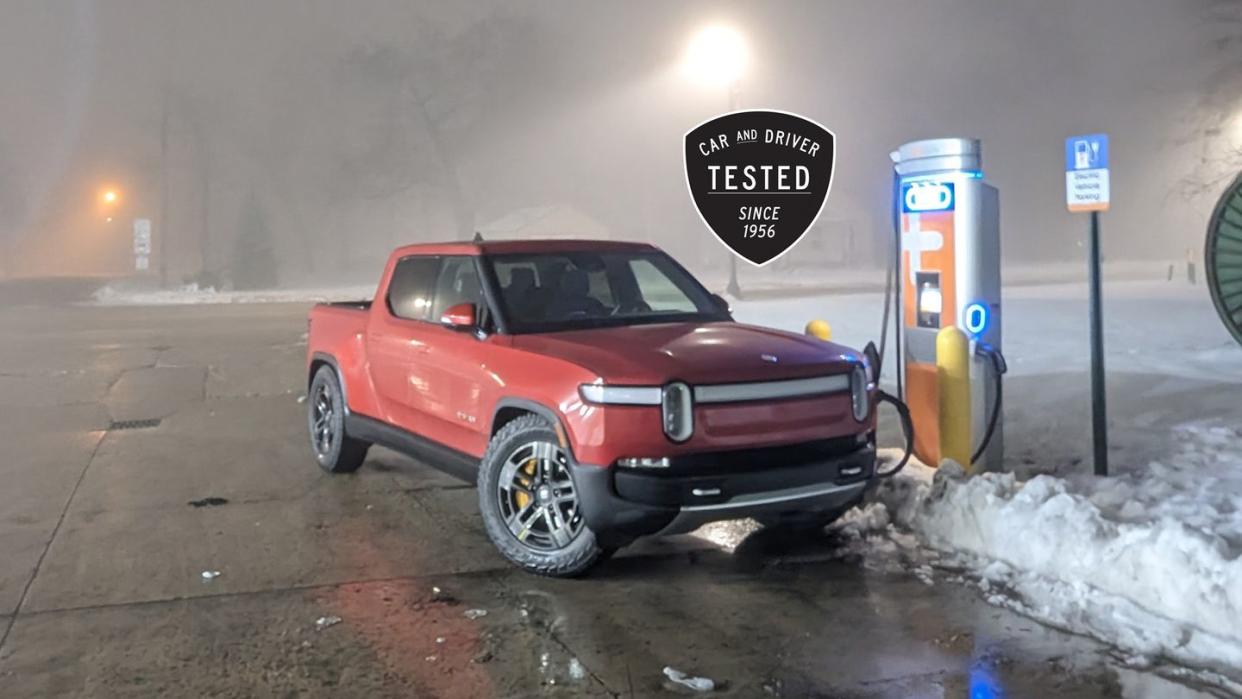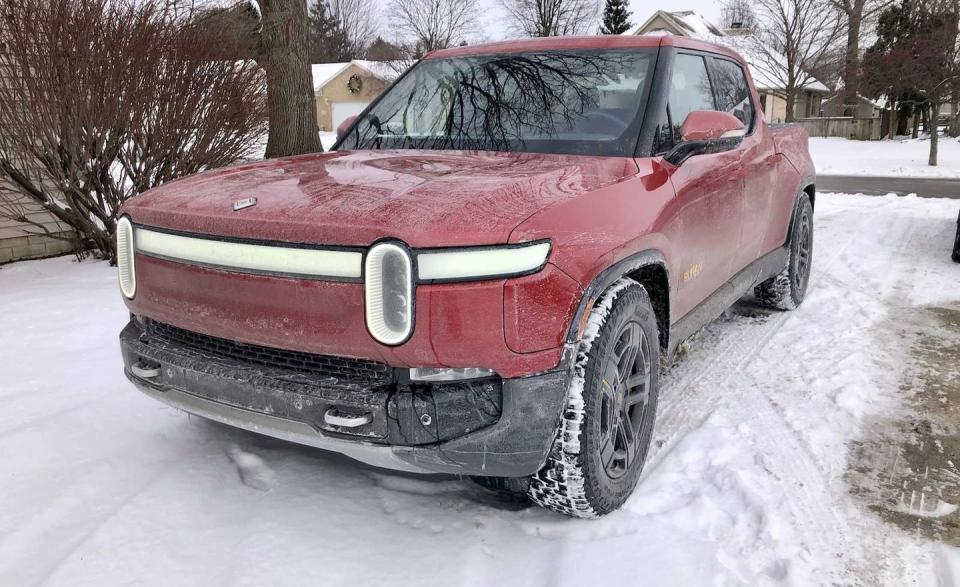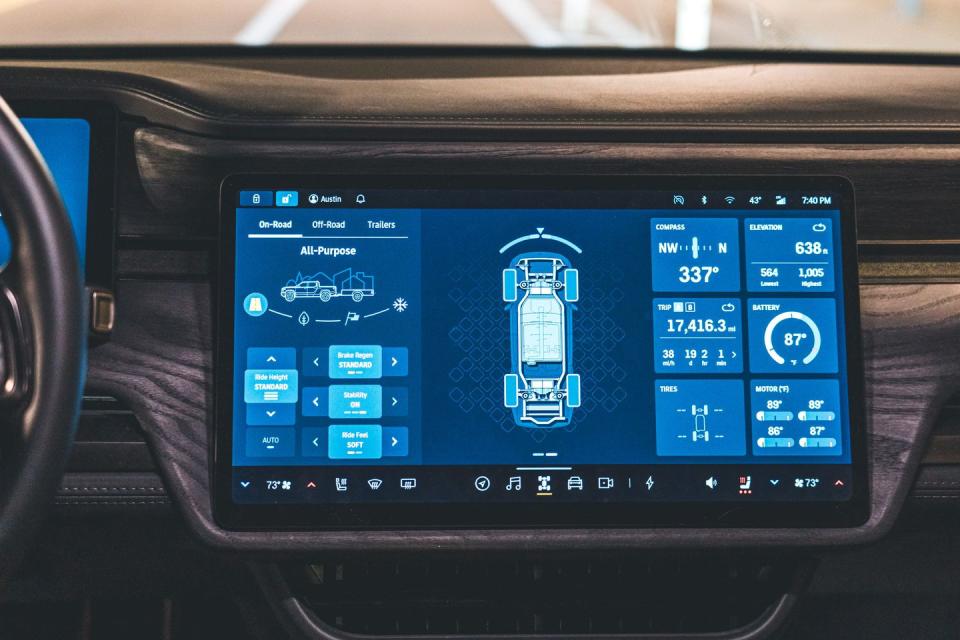Testing Our Rivian R1T Shows How Cold Temps Affect an EV's Range

The U.S. Department of Energy says an EV's range can drop by around 41 percent in subfreezing temps, so we used our long-term Rivian R1T to explore that claim.
In our real-world highway range test, we saw the R1T's result drop from 250 miles on a 42-degree day to 190 miles in 12-degree weather—a 27 percent difference.
While the cold didn't affect our electric truck's range as much as the DOE suggests, there are myriad factors at play, and EVs manage extreme temps in different ways.
Welcome to Car and Driver's Testing Hub, where we zoom in on the test numbers. We've been pushing vehicles to their limits since 1956 to provide objective data to bolster our subjective impressions (you can see how we test here).
This past winter in Michigan, where our editorial office is based, was the warmest in 125 years, according to the National Weather Service. Still, there were days below freezing that prevented Detroit from feeling like the Maldives. Not that anyone could mistake the two. When temperatures drop, so does the efficiency of vehicles. This information is neither new nor only applicable to electric cars, but we did feel compelled to illustrate this issue with another test.
The U.S. Department of Energy says a gas-powered car's fuel economy can be as much as "15 percent lower at 20 degrees Fahrenheit than it would be at 77 degrees Fahrenheit." However, the effect is far more dramatic with electric vehicles. The DOE says that "fuel economy can drop roughly 39 percent in mixed city and highway driving, and range can drop by 41 percent" for EVs.
Those percentage drops in efficiency are enough to give anyone the chills. With a 7054-pound Rivian R1T electric truck at our disposal, we decided to test the government's estimates using our 75-mph real-world highway range test in normal and below-freezing temperatures.

When our long-term Rivian arrived nearly a year ago, it completed a range test in 42-degree weather, traveling 250 miles from 100 percent to zero. That's 39 miles short of its estimate, but considering how few EVs ever come close to matching their EPA estimate in our highway test, the 14 percent delta is respectable.
During a 12-degree day, the same dual-motor R1T, albeit with fresh tires and about 20,000 miles of everyday use, managed to travel only 190 miles during our highway range test—a 27 percent drop in range at a 30-degree drop in temperature. So, not as scary as the DOE's estimate, but enough to make us curious.
One could argue using cold weather accessories such as heated seats, a heated steering wheel, and a more aggressive climate-control setting to heat the cabin all contribute to higher energy use during the winter. But while it's true more powered items do increase consumption, we always do our range tests the same way with the climate set to 72 auto and no other accessories, such as heated or ventilated seats.

Because we're unable to measure the specific components that cause the drop in range during the colder months, we asked Rivian's senior director of powertrain and thermal engineering, Henry Huang, about the science behind what vehicles give up when temps go down.
"As the vehicle drives down the road, you'll have more losses. There's no such thing as a perfectly sealed cabin." Huang pointed out that the R1T uses a resistive PTC heater to warm its cabin. "Think of it as a gigantic space heater. In our case, many, many kilowatts, instead of a smaller 1.5-kW heater for under your desk. It's a device that directly converts current into heat directly onto the blower and then out the vents."
So, while we keep the automatic climate control set to 72 degrees Fahrenheit in every car we range test, the PTC air heater will use more energy to maintain that 72 degrees as the cabin loses temperature from driving through the colder environment. Your parents have probably yelled at you for "heating the outdoors" by leaving a door cracked open. Turns out, they do it every day on the way to work.
When it comes to maintaining battery temperature, Huang explained the Rivian's thermal system decides what the optimal temperature of the 128.9-kWh liquid-cooled battery should be based on three large factors: ambient temperature, overall load of the system (i.e. is it towing?), and how many passengers are in the cabin. We were curious if the R1T was also burning up its range to keep the battery at a specific temperature and how wide that range may be.
"It's not just one target temperature, it's a fairly wide range," Huang explained. "The impact of the temperatures in your test is pretty minimal, so [probably] not worth expending extra energy to condition the battery for that. When you start getting into the dramatically cold or hot [temperatures], like at -22 degrees or 110 degrees Fahrenheit, it's for sure going to work harder to protect the battery pack."

We also wanted to know about loss in extreme temperatures overnight. As a preventive measure to keep battery cells from turning into goo in the freezing cold, how does the Rivian heat its pack when parked and unplugged?
"There's always a balance in using energy to keep the battery healthy without using too much of the truck's range while parked. In extreme situations, such as -22-degree temperatures, you've gotta protect the pack. The motors will generate heat—at zero torque—all of the energy going into that unit is to generate heat to keep the battery warm instead of power to move the truck."
One interesting factoid is that while the R1T uses a resistive heater, the upcoming Rivian R2 and smaller R3 hatchback use a more efficient heat pump. Huang tells us they made the switch because it's more efficient, and in electric vehicles, the thermal system is possibly the biggest player in overall vehicle efficiency in frigid temperatures.
While our home state of Michigan is known for its unpredictable weather, less anyone forget the snowstorm on May 9, 1923, where Detroit was left with six inches of snow, we think the colder temperatures won't be a bother for any of our test cars until next winter. That said, perhaps we repeat a range test if temperatures reach smoldering this summer.
You Might Also Like

